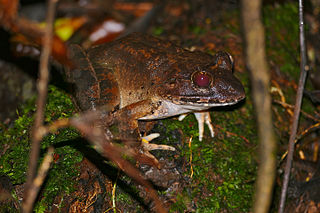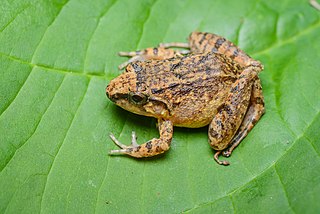
Limnonectes is a genus of fork-tongued frogs of about 75 known species, but new ones are still being described occasionally. They are collectively known as fanged frogs because they tend to have unusually large teeth, which are small or absent in other frogs.

Limnonectes hascheanus is a species of frog in the family Dicroglossidae. It is found in the Malay Peninsula ; its occurrence in the Andaman Islands requires confirmation. It is a small frog, males being 19–25 mm (0.75–0.98 in) and females 21–25 mm (0.83–0.98 in) snout-vent length.
Limnonectes kenepaiensis is a species of frog in the family Dicroglossidae. It is endemic to western Borneo and occurs in both Kalimantan (Indonesia) and Sarawak (Malaysia), and perhaps in Sabah (Malaysia). Common name Kenepai wart frog has been coined for it. It was first described as subspecies of Limnonectes paramacrodon, which it resembles.

The giant river frog is a species of frog in the family Dicroglossidae. It is endemic to Borneo, and found in Brunei, Kalimantan (Indonesia), and Sabah and Sarawak (Malaysia).

Limnonectes limborgi is a species of frog in the Dicroglossidae. It is found in Burma, Thailand, Cambodia, Laos, and Vietnam; it might well occur in Northeast India and Yunnan, China. It is a small frog, males being 30–38 mm (1.2–1.5 in) and females 28–36 mm (1.1–1.4 in) snout-vent length.

Limnonectes paramacrodon is a species of frog in the family Dicroglossidae. It is found in Malay Peninsula, Borneo, and Natuna Besar. Its natural habitats are lowland swamp forest areas with small rivers and streams. It is becoming rare due to habitat loss.
Djoko Tjahjono Iskandar is an Indonesian herpetologist who studies the amphibians of Southeast Asia and Australasia. He is a professor of biosystematics and ecology at Bandung Institute of Technology in West Java, Indonesia.

Robert Frederick Inger was an American herpetologist. During his lifetime, he wrote numerous books and publications about herpetology. He was also the curator for amphibians and reptiles at the Field Museum in Chicago, Illinois.
The river frog is a species of aquatic frog in the family Ranidae.
Limnonectes jarujini is a species of frog in the family Dicroglossidae, first described from near Kaeng Krachan Dam, Thailand. It occurs in southwestern and southern, peninsular Thailand, and likely in adjacent southern Myanmar. It has been recorded from Kanchanaburi, Surat Thani, and Nakhon Si Thammarat provinces.
Limnonectes taylori is a species of frogs in the family Dicroglossidae, first described from Doi Inthanon, Thailand. It occurs in northwestern Thailand and into northern Laos and extreme east-central Myanmar, possibly into adjacent Vietnam. In Thailand, it occurs in the provinces Chiang Mai, Mae Hong Son, Lampang, Nan, and Tak.
Limnonectes cintalubang is a species of fanged frogs in the family Dicroglossidae. It is endemic to western Sarawak, Malaysia. It is closely related to Limnonectes hikidai.
Limnonectes hikidai is a species of fanged frogs in the family Dicroglossidae. It is endemic to Sarawak, Malaysia. Its type locality is Mount Serapi in Kubah National Park, Matang, Kuching District, Sarawak, Malaysia. It is closely related to Limnonectes cintalubang.
Limnonectes bannaensis is a species of frogs in the family Dicroglossidae. It is found in southern China, Laos, Thailand and Vietnam.
Limnonectes deinodon is a species of fanged frogs in the family Dicroglossidae. It is endemic to peninsular Malaysia and likely also southern Thailand. It was previously confused with Limnonectes laticeps and Limnonectes khasianus.
Limnonectes selatan is a species of fanged frogs in the family Dicroglossidae. It is endemic to peninsular Malaysia, in the states of Pahang and Selangor.
Limnonectes ferneri is a species of fanged frogs in the family Dicroglossidae. It is endemic to Mindanao, Philippines, where it was recorded on Mount Pasian, Monkayo, Compostela Valley.
Limnonectes sisikdagu is a species of fanged frogs in the family Dicroglossidae. It is endemic to West Sumatra, Indonesia, where its holotype was found near Solok. It is part of the Limnonectes kuhlii species complex.
Limnonectes quangninhensis is a species of fanged frog in the family Dicroglossidae. Its type locality is Quảng Sơn Commune, Hải Hà District, Quảng Ninh Province, Vietnam, where it was found in an evergreen forest near Tai Chi Village. It is found in islands of the Gulf of Tonkin, and is also likely found across the border in Fangchenggang, Guangxi, China. It is a sister taxon to Limnonectes fujianensis.

Gosner stage is a generalized system of describing stages of embryonal and larval development in anurans. The Gosner system includes 46 numbered stages, from fertilized embryo to the completion of metamorphosis. It was introduced by Kenneth Gosner in 1960. The system is widely used in herpetology to describe exotrophic tadpoles. Gosner stages are based on certain morphological landmarks that allow comparing development in different species that may greatly differ in age or size.






